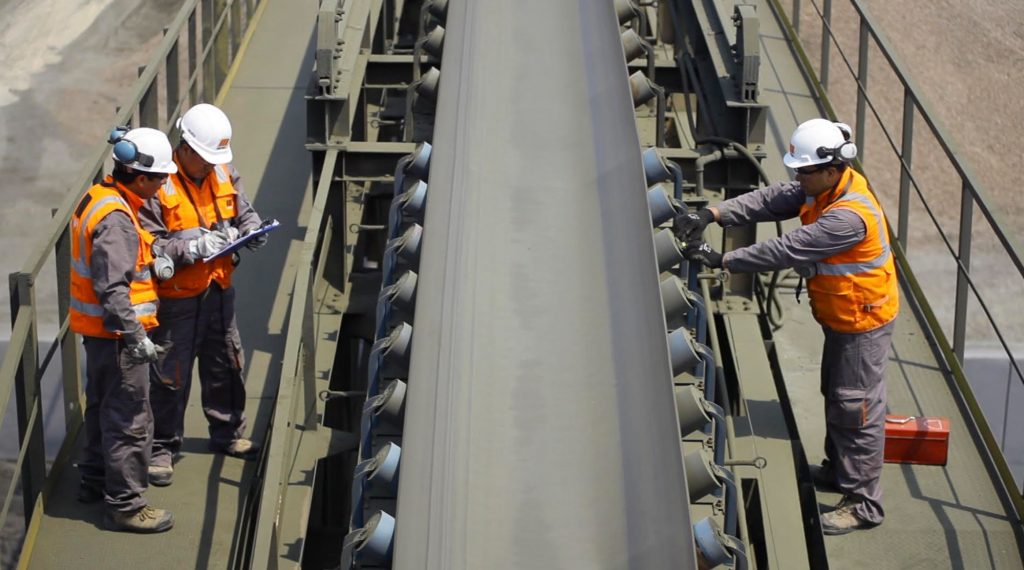Tips for safely working around conveyors


Because of their size, speed and high-horsepower drive motors, conveyors pose a number of risks to personnel working on or near them. In addition to all of the physical danger zones, when an injury occurs, “fault” is often attributed to injured workers’ actions or inactions. However, safety experts point out that injuries generally occur due to a series of factors.
“Accidents are typically a result of a complex combination of probabilities, rather than a single unsafe act,” observed Martin Engineering process engineer Daniel Marshall. “Except for the unsafe act, it can be said that the accident would not have occurred if there was a safer design, better maintenance or less pressure for production.”
A thorough risk assessment by trained professionals is the ideal way to bridge the gap between workers and managers when the rules need review, to identify hazards and implement controls to reduce risks.
A typical conveyor belt moves at a relatively constant speed, commonly running between 0.5 to 10 meters per second. At the very minimum, a worker who inadvertently touches a running conveyor belt – even with world-class reaction time and total focus on the danger of a conveyor – will come in contact with at least one carrying idler, and the potential is there to hit return idlers, chute uprights, stringer supports, pulleys and drives. The results are often disastrous.
It’s been estimated that two-thirds of the fatalities involving conveyor belts take place while the belt is moving, usually as a result of a worker becoming entangled or crushed by moving equipment. The majority of these take place when maintenance or housekeeping is being done on or around an energized conveyor.
These fatalities are generally caused by two compounding practices. The first is performing maintenance without thoroughly locking, tagging, blocking and testing the conveyor. Another unsafe practice is touching a moving conveyor belt with a tool or implement of any kind. When these two choices are combined, the results are usually severe and often fatal. Even working on a conveyor that is turned off, but not locked out, can lead to tragedy.
Workaround and Shortcuts
“An intelligent and creative worker will often invent or discover ways to expedite certain functions or make work easier,” Marshall said. “Unfortunately, some of these shortcuts bypass safety hardware and/or best practices, putting the worker in harm’s way.”
The most common of these workarounds involves the improper locking out of a conveyor system. The purpose of a lockout is to de-energize all sources of energy, whether latent or active. Failure to properly lockout can exist in many forms – varying from disregarding lockout requirements, to working on a moving conveyor, to improperly stopping the conveyor. An example would be pulling the emergency-stop cord and assuming that the conveyor is de-energized.
Another common workaround involves entering a confined space without following established procedures. Very specific rules apply to workers when dealing with confined spaces. Failure to follow those rules can result in increased danger or death.
Other potential unsafe behaviors include crossing a conveyor in a risky manner. Conveyor belts are often lengthy systems bisecting a production facility. Workers may be required to cross a conveyor line to get to an area that is in need of service or maintenance. To save time, a worker is likely to step over or cross under a conveyor.
Crossing under offers multiple hazards. If any of the worker’s body parts come in contact with the moving conveyor, it will either act like a grinder and abrade the skin or pull the worker toward rolling components. Crossing under also places the worker at risk from falling objects.
Crossing over a conveyor without using a designed and designated crossover structure offers dangers, as well. There is a high potential for a slip and fall. If lucky, the worker may fall on the ground; if not, the worker will fall onto the conveyor belt. If the conveyor is in operation, the worker may be carried downstream. This can result in contact with the conveyor structure and rolling components or being thrown off the conveyor at the discharge.
Anything in a worker’s line of travel is a potential obstruction. These can range from piles of spillage, items lying on the walkway or work areas, as well as low overheads. An obstruction can cause several hazards, the most obvious being the opportunity for a trip or fall. If the obstruction is in the middle of the walkway, a worker will have to go around it. If that revised path brings the worker closer to a conveyor, this decision places the worker closer to the hazards of the conveyor.
“While even one unsafe practice has the statistical potential to lead to serious repercussions, conveyor accidents are rarely the result of a single action,” Marshall concluded. “More often, they result from a combination of company culture and unwise decisions. If workers can eliminate these unsafe practices and minimize their presence in danger zones, their chances of avoiding an accident will improve considerably.” Please visit www.Martin-Eng.com for solutions to bulk material handling.
Comments